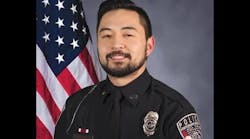Washington D.C is not a place many would consider a key location for technology. But when it applies to aviation, and you are one of a very select group of aircraft given permission to fly in an area widely considered some of the most restricted and secure airspace in the world, technology is essential--not only for the safe operation of aircraft, but as it pertains the way airborne law enforcement missions are achieved in the nation's capital.
The United States Park Police (USPP) is the law enforcement arm of the National Parks Service. It is the oldest uniformed federal law enforcement entity in the United States, predating even its parent government department the National Parks Service by 50 years. The USPP is responsible for law enforcement in national parks around the country and in the Washington DC area, all of Washington D.C's nationally significant monuments, some roadways in the metro DC area, and many buildings under the jurisdiction of the National Parks Service. The unit is one of very few federal law enforcement agencies that has the power to make arrests under state and federal authority, due to their unique mission that is carried out on both local and federal land.
USPP takes to the air
The aviation section of the United States Park Police was commissioned in 1973 and started with just a single Bell 206 JetRanger helicopter, three pilots and three rescue technicians. As the unit's operations, location and staffing grew over the years, so too did their reliance on technological advancements in the law enforcement aviation sector to assist them in furthering their capabilities to provide lifesaving services.
While helicopters are complex pieces of machinery that rely heavily on technology to operate, when conducting a law enforcement helicopter operations, the reliance on technology increases significantly.
Lieutenant Simeon Klebaner serves as the commander of the United States Park Police aviation unit and believes that without technology, the aviation unit would not be able to provide the services it does to the community and to law enforcement agencies that they provide service to on a regular basis.
The two primary aircraft assigned to the aviation unit are a 1991 Bell 412 SP and a 1999 Bell 412 EP, supplemented by a Bell 206L3 JetRanger, which is although a newer aircraft, is still the same type of helicopter that the unit started their operations with, in 1973.
The Bell 412 helicopter conducts missions such as search and rescue that often involves winch rescues in the District of Columbia and surrounding counties as one of the few agencies equipped for long line rescue operations via winch. The unit also serves as a primary medevac helicopter, is equipped to carry out SWAT insertions and conducts routine patrol of the nation’s capital, assisting in specialized homeland security operations, including providing airborne support to the United States Secret Service regularly during presidential movements.
Learning to fly (and see in the dark)
USPP employs various types of technology to accomplish its diverse missions. Essential equipment utilized by the aviation unit helicopter operations includes a Spectrolab NiteSun SX 16 illumination system which illuminates ground objects with a 30-40 million candle power light beam that can be directed via control from the crew aboard the helicopter. The Nitesun is used in addition to a FLIR 8500 Multi camera system, providing both day and night vision capabilities, giving flight crews the ability to "see in the dark". Crews can utilize standard camera functions during daylight hours, and either the NiteSun unit and day camera or forward looking infra red (FLIR) at night. The FLIR system is considered one of the primary pieces of equipment in any law enforcement helicopter for both law enforcement missions and search and rescue. The infrared camera is capable of detecting even the smallest amount of body heat amongst other objects due to the stark contrast provided by objects that emit a heat signature in a cold environment, providing a bright white illumination against a mostly dark background with objects that do not emit heat.
All of the flight crews have also been factory trained in the use of night vision goggles (NVG's), which enhance both pilot and observer visibility at night. Although at this stage, Lt. Klebaner stated that to effectively utilize night vision goggles, an NVG compatible cockpit must be installed in the helicopter. This type of cockpit lighting configuration produces very low light emissions and is specifically designed to work in unison with the use of NVG technology, to provide a cockpit that will not produce strong light that would render instruments unreadable through NVG units. At this stage the USPP aviation unit has not decided on which way to proceed in delivering this much needed technology to improve the safety of night operations, and currently only conduct missions in visual flight rules (VFR) conditions.
The USPP aviation unit conducts almost 4000 missions yearly, averaging over 1000 hours airborne amongst the three helicopters, with homeland security and law enforcement flights being their most common deployments, closely followed by medevac and rescue missions, which numbered almost 400 deployments in 2014.
Florida Airlines Flight 90
Rescue work in a helicopter is often the most demanding of challenges faced by a pilot, and the USPP aviation unit is no stranger to high profile rescue missions. One of its most notable rescues occurred on January 13th, 1983, a bitterly cold day (even by D.C standards) with light snow. The unit was unaware that at 4pm that afternoon their rescue skills would be put to the ultimate test. The rescue that follow was unlike any other performed before, and it is still regarded as one of the most dramatic rescues ever caught on film.
Florida Airlines flight 90 took off from from Washington National Airport shortly before 4pm, but due to a series of pilot errors did not activate the aircraft’s de-icing equipment. The Boeing 737 aircraft struggled to achieve takeoff speed, using almost double the usual amount of runway and remained in the air less than 30 seconds, attaining an altitude of just 352 feet before falling out of the sky over downtown DC at the beginning of an early rush of traffic due to an impending blizzard.
As the plane descended into the Anacostia River, the Boeing 737 impacted the 14th Street Bridge crushing seven cars, killing four people on the bridge, 74 passengers and four of the five crew on board. USPP helicopter, Eagle 1, was dispatched and arrived on scene at 4:20pm. The crew noted six survivors in the water, clinging to the tail section of the plane--the only part of the 737 not submerged. Early rescue efforts from bystanders at the scene had failed due to the sub zero temperature of the water. The frigid temps prevented any of the would-be rescuers from getting more than 30 feet into the water before becoming hypothermic and having to be dragged back to shore.
In 1983, rescue winches were not widely used by helicopters in law enforcement, so the rescue technician on board the helicopter, Paramedic Melvin D. Windsor, lowered a rescue line to the freezing victims one by one as pilot Donald W. Usher expertly piloted the helicopter precariously low to the water’s surface to allow survivors to grab the rescue line and be dragged to shore through the icy water to waiting rescuers. Officer Windsor at one point was forced to step out onto the helicopter’s skid to recover a survivor who had initially grabbed the recue line, but had fallen back into the water on the first attempt. Officer Windsor was able to locate the woman submerged under water and directed Pilot Usher to descend as low as possible to allow him to reach into the icy water to recover her. At one point, the Bell 206’s skids were submerged underwater in order for officer Windsor to grab her by clothing to hold her by hand on the skid of the helicopter to get her to shore.
One of the most tragic stories of this incident is that of Arland D. Williams, who was severely injured in the crash and was still strapped into his seat, unable to extricate himself. Mr. Williams can be seen in footage of the incident receiving the rescue line three times, and each time, selflessly handing it off to other survivors. On their final return trip to rescue Mr. Williams, tragically, the flight crew discovered that the wreckage had shifted and submerged Mr. Williams, becoming the only crash survivor to drown well after the crash during rescue efforts.
Winch rescue and digital multiband radio
In the wake of the tragedy of flight 90, unit commanders realized they needed the ability of a winch capable aircraft to affect timely rescue efforts. In 1991 UPPS purchased a twin engine Bell 412SP fitted with a Goodrich hoist system, capable of winching at a speed of 275 feet per minute, and providing a useful load capacity of 600 pounds. The winch technology employed is one of only two main winch technology systems used across almost all airborne law enforcement aircraft. In 2014, the United States Park Police Aviation unit conducted more than 400 missions in which they deployed the winch in their service area.
While analog technology such as winching systems play a big part in the rescue operations capacity of the unit, digital technology also plays a large part of their day to day operations. When Eagle 1 is airborne over the nation’s capital, they have the ability to communicate with literally dozens of state, federal and local law enforcement agencies through their bank of multiband radios, covering bands in UHF and VHF frequencies from 500-880Mhz. This multiband radio system can be used by both the pilot and copilot to operate separate radios if required.
The most secure airspace in the world is also one of the most complex to operate in, and can require at times the need to speak to air traffic control at nearby Washington National Airport, Andrews Air Force Base, other authorized aircraft in the airspace, as well as several ground agencies all in one single flight--a task not for the easily confused.
In addition to the complex array of radio technology on board Eagle 1, the unit also employs an Aero Computers moving map system. Allowing crews access to current maps of the DC Metro and surrounding service areas. The moving map hardware mounted in the aircraft couples with a GPS based mapping system that moves with the helicopter, constantly triangulating the location of the helicopter on the map. The difference between a standard vehicle GPS system and something you would find in a helicopter based system, is the ability for flight crews to input an address and the Aero Computers system that will then calculate a compass heading for the helicopter to follow, giving the helicopter the most direct and timely route to travel to get to an incident scene.
Downlink and live feeds
Eagles 1 and 2, are also outfitted with a partial autopilot that allows the ability for the pilots to program and follow a compass heading automatically, once at a selected altitude. Downlink technology is still in its infancy of being adopted by law enforcement while they try to plan how to best use it effectively. However, the United States Park Police was an early adopter of this technology, based on their proximity to the White House and nationally significant infrastructure, such as the Pentagon and Congress, and the amount of high profile work they conduct on a daily basis. While the aviation unit cannot divulge the type of downlink technology they employ due to national security concerns, the downlink technology used has several methods of transmitting live camera feeds of what their camera sees from the air to ground locations. The unit has the ability to send a live feedback to their own base at the Eagles Nest, to a USPP mobile command center, or to a proprietary mobile base unit that can be used by certain entities if needed. The footage can also be transmitted to several secured mobile devices of authorized users in the field if required.
One recent high profile use of that technology was during the Navy yard active shooter incident September 16. 2013. The aviation unit's hangar is located directly opposite the Washington D.C Navy yard. Within mere minutes of the notification, Sergeant pilot Kenneth Burchell and rescue technician Sergeant David Tolson were airborne and requesting additional air assets to assist. Once on-scene above the Navy Yard, Eagle 1 crew requested flight diversions for incoming aircraft to Washington National Airport and was already coordinating the arrival of other aircraft, positioning them, and assigning roles. Their multi mission capability was tested during this incident as they returned to the Eagles Nest to pick up a SWAT officer to deploy on the roof of building 197, where the active shooter was thought to be located. Soon after the SWAT officer entered the building from the rooftop, he reappeared with a critically injured female that needed to be extracted from the rooftop for urgent medical attention.
Eagle 1 hoisted the injured female into the helicopter and transported her to a local area hospital for treatment before returning to the Eagles Nest to pick up additional SWAT. The aircraft was in the air for more than 5 hours during the incident, providing air traffic control, rescue extraction and SWAT insertion missions, all while providing a downlink of footage to the mobile command post to assist with coordination and response from the various law enforcement agencies on site. Sergeants Tolson and Burchell were awarded the air crew of the year award for their efforts on that day by the Airborne Law Enforcement Association at their annual convention in Phoenix, Arizona in July of 2014.
When talking about the future of their technology solutions and helicopters, Klebaner says they have been very impressed with the technology they have been able to source over the years, but as aircrafts start to age replacements are always a concern for the future, due to the substantial cost associated with replacements.
When asked if the aviation unit would stay with their current type of helicopter in the future if the opportunity arises to seek a replacement aircraft, Klebaner stated they have a successful accident-free, 38-year relationship with Bell Helicopter, and for the mission profile the unit has, he would be hard pressed to find a replacement helicopter that would equal the performance, cost effectiveness and reliability of the Bell products currently use at the USPP aviation unit. They are also at the forefront of technology and training, adding that the factory training program that all pilots are required to attend conducted by Bell Helicopter at their facilities in Texas for their 412 and 206 helicopters, has been incredibly beneficial to their program; pilots gain valuable knowledge with every attendance.



